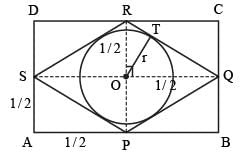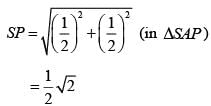Mechanical Engineering Exam > Mechanical Engineering Questions > A rhombus is formed by joining the midpoints ...
Start Learning for Free
A rhombus is formed by joining the midpoints of the sides of a unit square.
Q. What is the diameter of the largest circle that can be inscribed within the rhombus?
Q. What is the diameter of the largest circle that can be inscribed within the rhombus?
- a)1/√2
- b)1/2√2
- c)√2
- d)2√2
Correct answer is option 'A'. Can you explain this answer?
Most Upvoted Answer
A rhombus is formed by joining the midpoints of the sides of a unit sq...
To find the diameter of the largest circle that can be inscribed within the rhombus, we need to find the length of the diagonal of the rhombus.
The sides of the rhombus are formed by joining the midpoints of the sides of the unit square. Since each side of the square has length 1, the sides of the rhombus also have length 1.
The diagonals of a rhombus bisect each other at right angles. Since the sides of the rhombus have length 1, the diagonals are also of length 1.
Now, let's draw the rhombus:
```
A
D-----C
| |
| O |
| |
B-----E
F
```
Let A, B, C, and D be the vertices of the rhombus, and let E be the midpoint of AB and F be the midpoint of BC. The circle with the largest diameter that can be inscribed within the rhombus is tangent to the sides of the rhombus at the midpoints E and F.
Let O be the center of the circle. Since the circle is tangent to the sides of the rhombus at E and F, the radii of the circle are perpendicular to the sides EF and CF.
Since EF is the diagonal of a square with side length 1, EF has length sqrt(2).
Since the diagonals of a rhombus bisect each other at right angles, the length of CF is half the length of the diagonal AC. Since AC has length 1, CF has length 1/2.
Using the Pythagorean theorem, we can find the length of OF:
OF^2 = OC^2 - CF^2
OF^2 = 1/2^2 - 1/2^2
OF^2 = 1/4 - 1/4
OF^2 = 0
This means that OF has length 0, so the circle with the largest diameter that can be inscribed within the rhombus is a point circle. The diameter of this circle is 0.
Therefore, the diameter of the largest circle that can be inscribed within the rhombus is 0.
The sides of the rhombus are formed by joining the midpoints of the sides of the unit square. Since each side of the square has length 1, the sides of the rhombus also have length 1.
The diagonals of a rhombus bisect each other at right angles. Since the sides of the rhombus have length 1, the diagonals are also of length 1.
Now, let's draw the rhombus:
```
A
D-----C
| |
| O |
| |
B-----E
F
```
Let A, B, C, and D be the vertices of the rhombus, and let E be the midpoint of AB and F be the midpoint of BC. The circle with the largest diameter that can be inscribed within the rhombus is tangent to the sides of the rhombus at the midpoints E and F.
Let O be the center of the circle. Since the circle is tangent to the sides of the rhombus at E and F, the radii of the circle are perpendicular to the sides EF and CF.
Since EF is the diagonal of a square with side length 1, EF has length sqrt(2).
Since the diagonals of a rhombus bisect each other at right angles, the length of CF is half the length of the diagonal AC. Since AC has length 1, CF has length 1/2.
Using the Pythagorean theorem, we can find the length of OF:
OF^2 = OC^2 - CF^2
OF^2 = 1/2^2 - 1/2^2
OF^2 = 1/4 - 1/4
OF^2 = 0
This means that OF has length 0, so the circle with the largest diameter that can be inscribed within the rhombus is a point circle. The diameter of this circle is 0.
Therefore, the diameter of the largest circle that can be inscribed within the rhombus is 0.
Free Test
FREE
| Start Free Test |
Community Answer
A rhombus is formed by joining the midpoints of the sides of a unit sq...
Let ABCD be the square of unit length and P, Q, R, S be midpoints of AB, BC, CD, DA respectively

Let O be centre of circle
OR = OQ = 1/2 units

SP = PQ = RQ = PS (rhombus)
Area of ΔORQ = 1/2OROQ
= 1/2O x RQ

Diameter = 2r = 1/√2
Hence, the correct option is (A).

Let O be centre of circle
OR = OQ = 1/2 units

SP = PQ = RQ = PS (rhombus)
Area of ΔORQ = 1/2OROQ
= 1/2O x RQ

Diameter = 2r = 1/√2
Hence, the correct option is (A).

|
Explore Courses for Mechanical Engineering exam
|

|
Similar Mechanical Engineering Doubts
A rhombus is formed by joining the midpoints of the sides of a unit square.Q. What is the diameter of the largest circle that can be inscribed within the rhombus?a)1/√2b)1/2√2c)√2d)2√2Correct answer is option 'A'. Can you explain this answer?
Question Description
A rhombus is formed by joining the midpoints of the sides of a unit square.Q. What is the diameter of the largest circle that can be inscribed within the rhombus?a)1/√2b)1/2√2c)√2d)2√2Correct answer is option 'A'. Can you explain this answer? for Mechanical Engineering 2025 is part of Mechanical Engineering preparation. The Question and answers have been prepared according to the Mechanical Engineering exam syllabus. Information about A rhombus is formed by joining the midpoints of the sides of a unit square.Q. What is the diameter of the largest circle that can be inscribed within the rhombus?a)1/√2b)1/2√2c)√2d)2√2Correct answer is option 'A'. Can you explain this answer? covers all topics & solutions for Mechanical Engineering 2025 Exam. Find important definitions, questions, meanings, examples, exercises and tests below for A rhombus is formed by joining the midpoints of the sides of a unit square.Q. What is the diameter of the largest circle that can be inscribed within the rhombus?a)1/√2b)1/2√2c)√2d)2√2Correct answer is option 'A'. Can you explain this answer?.
A rhombus is formed by joining the midpoints of the sides of a unit square.Q. What is the diameter of the largest circle that can be inscribed within the rhombus?a)1/√2b)1/2√2c)√2d)2√2Correct answer is option 'A'. Can you explain this answer? for Mechanical Engineering 2025 is part of Mechanical Engineering preparation. The Question and answers have been prepared according to the Mechanical Engineering exam syllabus. Information about A rhombus is formed by joining the midpoints of the sides of a unit square.Q. What is the diameter of the largest circle that can be inscribed within the rhombus?a)1/√2b)1/2√2c)√2d)2√2Correct answer is option 'A'. Can you explain this answer? covers all topics & solutions for Mechanical Engineering 2025 Exam. Find important definitions, questions, meanings, examples, exercises and tests below for A rhombus is formed by joining the midpoints of the sides of a unit square.Q. What is the diameter of the largest circle that can be inscribed within the rhombus?a)1/√2b)1/2√2c)√2d)2√2Correct answer is option 'A'. Can you explain this answer?.
Solutions for A rhombus is formed by joining the midpoints of the sides of a unit square.Q. What is the diameter of the largest circle that can be inscribed within the rhombus?a)1/√2b)1/2√2c)√2d)2√2Correct answer is option 'A'. Can you explain this answer? in English & in Hindi are available as part of our courses for Mechanical Engineering.
Download more important topics, notes, lectures and mock test series for Mechanical Engineering Exam by signing up for free.
Here you can find the meaning of A rhombus is formed by joining the midpoints of the sides of a unit square.Q. What is the diameter of the largest circle that can be inscribed within the rhombus?a)1/√2b)1/2√2c)√2d)2√2Correct answer is option 'A'. Can you explain this answer? defined & explained in the simplest way possible. Besides giving the explanation of
A rhombus is formed by joining the midpoints of the sides of a unit square.Q. What is the diameter of the largest circle that can be inscribed within the rhombus?a)1/√2b)1/2√2c)√2d)2√2Correct answer is option 'A'. Can you explain this answer?, a detailed solution for A rhombus is formed by joining the midpoints of the sides of a unit square.Q. What is the diameter of the largest circle that can be inscribed within the rhombus?a)1/√2b)1/2√2c)√2d)2√2Correct answer is option 'A'. Can you explain this answer? has been provided alongside types of A rhombus is formed by joining the midpoints of the sides of a unit square.Q. What is the diameter of the largest circle that can be inscribed within the rhombus?a)1/√2b)1/2√2c)√2d)2√2Correct answer is option 'A'. Can you explain this answer? theory, EduRev gives you an
ample number of questions to practice A rhombus is formed by joining the midpoints of the sides of a unit square.Q. What is the diameter of the largest circle that can be inscribed within the rhombus?a)1/√2b)1/2√2c)√2d)2√2Correct answer is option 'A'. Can you explain this answer? tests, examples and also practice Mechanical Engineering tests.

|
Explore Courses for Mechanical Engineering exam
|

|
Signup for Free!
Signup to see your scores go up within 7 days! Learn & Practice with 1000+ FREE Notes, Videos & Tests.
























